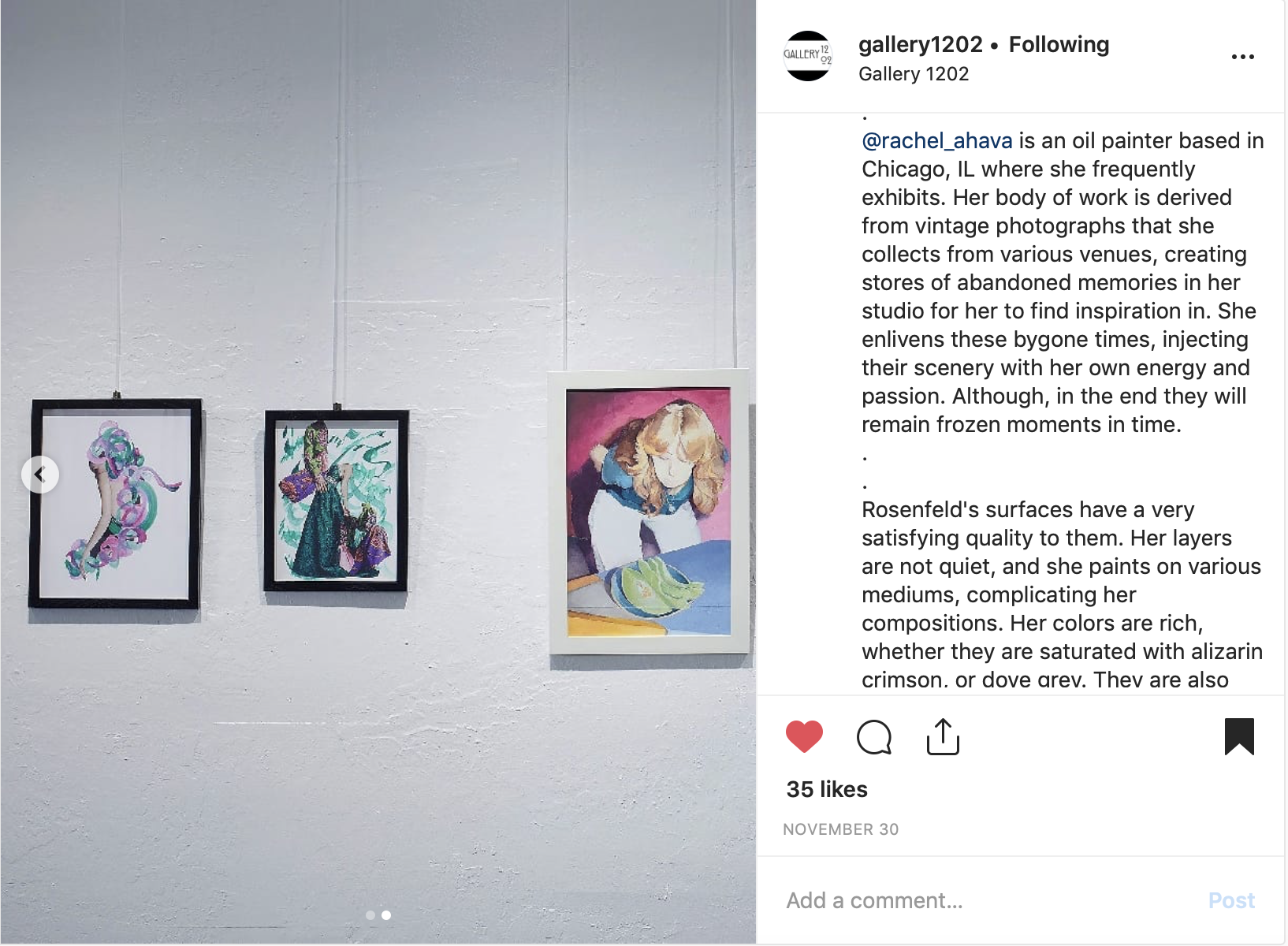FEATURED PRESS
RECENT SOCIAL MEDIA
AGITATOR GALLERY MEDIA RELEASE
Information poster for Agitator Gallery’s upcoming exhibition of Chicago figure paintings, including “Their eyes are windows (air-raid curtains)”
NIV MAGAZINE
ISSUE 12: JANUARY/FEBRUARY 2022
For the full text:
For the Full text of Ekphrasis magazine Issue Two:
She Makes Chicago
Maker spotlight: rachel ahava rosenfeld
(vignette posted on the she makes chicago blog January 22, 2020)
RACHEL AHAVA ROSENFELD SHARES HER PAINTING ADO AMONG THE RUINS AND HOW THE OBSERVATION AND HISTORY BEHIND THIS WORK SPARKED A DEEPER CONNECTION FOR HER TO THE CITY AS A NEW RESIDENT OF CHICAGO.
This painting was a real aha moment for me as a painter. It is fundamentally a landscape painting of the panoramic view of the alleyway, crowded with brick walls. At night, the alley seemed to melt away under the bizarre Orange-Cream glow of the streetlight underneath my window. Interestingly, these intensely orange lamps are a relic of a 1970’s effort made by city government to make the city look “less eerie”. One night, I began taping “ found” vintage snapshots and bright scraps of wrapping paper onto the windowpanes. The backlighting appeared to envelop the tiny portrait, seeping around her edges like an overbearing halo. I spent countless hours carefully recording the visual phenomena between the glass pane and the inky-amber void that stretched out behind it. From a painterly perspective, the color of the high pressure sodium bulbs was mesmerizing. Unsurprisingly, the rest of the city is significantly less enthusiastic about our fluorescent bulbs. The final product, Ado Among the Ruins, is a testament to Chicago’s ever changing character. It is a picture of impending nostalgia, seen through fresh eyes. That swath of pavement was the first part of Chicago that I learned by heart, and I will (quite literally) never see it in the same light again.
Full text available at She makes chicago
Ladies Drawing club
“collective memory (issue No. 3 Part 2)” January 2020
Full text can be accessed online via issuu.
*Click each page to view
The fat canary journal
featured artist: may 2019 by Virginia mallon
excerpt: Rachel credits a childhood spent exploring her mother’s office at the African Art Department of the Nelson-Atkins Museum of Art, for her “archeological” approach to art. We see this influence as she unearths facets of Americana through paintings inspired by found photographs. In this way, she launches a narrative with an “unknowable multitude frozen in time”, to create a dialogue as quintessentially American as lawn chairs, formica and beehive hairdos.
The esthetic apostle
“Opacity and the family album” July 2018
Excerpt: Rachel Ahava Rosenfeld is an oil painter living and working on the north side of Chicago. Originally from Kansas City, she has pursued her passion for oil painting through study at the Jerusalem Studio School, and research in Germany, Italy, France, and Ireland. Additionally, she received a B.A. in Studio Art from Hollins University, and M.F.A in Visual Arts from the Sam Fox School of Design and Visual Arts at Washington University in St. Louis.
MFA Catalog 2016
Included alongside classmates in pamphlet describing studio practices among graduate students at the sam fox school of art and design at washington university in st. louis. essay written by emmett catedral, photographs by jonathan p. berger.
Excerpt: “Her paintings invite the viewer to see a story that never existed, reminding her audience of the inherent fallibility of memory. the anonymous nature of the work allows for projection and subconscious personal authorship of the paintings’ interpretations. Though the scenes depicted are fictions, they become real when beheld as the viewer and the work seek mutual completion of the shared narratives (pg. 40).”
Command zine
“Featured artist interview: rachel rosenfeld” june 2017 by anna buckner
Excerpt: “The tension is a feeling that I think is pretty common to people like me, whose familial histories are absent, especially when parts of those histories have intentionally been withheld. It’s the notion that our culture, in my case American (or more specifically Midwestern, perhaps) culture tells us that it is healthy to be nostalgic. It is healthy to miss our parents’ and grandparents’ America. The tension manifests when one is forced to confront the problems that one’s family inevitably faced as they lived out these untold stories in the America that we are allegedly nostalgic for. The tension, I guess, is the knowledge that we are supposed to miss something that we know must have been problematic, without ever knowing exactly what those problems were. Trying to find these stories can be like knowing that a play is happening, but when you pull the velvet curtain aside there is a brick wall between you and the actors. Here we find the nature of history itself. The voices floating over the wall entice you with story scraps, but the brick wall won’t budge. I know that is a long answer, I your question basically embodies the monstrosity that is my MFA thesis. Svetlana Boym clarified this all with an impressive level of clarity when she discussed the concept of “Reflective Nostalgia” in her brilliant book The Future of Nostalgia.”























